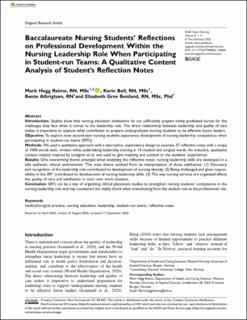| dc.contributor.author | Reime, Marit Hegg | |
| dc.contributor.author | Bell, Karin | |
| dc.contributor.author | Albrigtsen, Bente | |
| dc.contributor.author | Beisland, Elisabeth Grov | |
| dc.date.accessioned | 2022-12-27T11:00:51Z | |
| dc.date.available | 2022-12-27T11:00:51Z | |
| dc.date.created | 2022-10-19T09:52:43Z | |
| dc.date.issued | 2022 | |
| dc.identifier.citation | Sage Open Nursing. 2022, 8 1-11. | en_US |
| dc.identifier.issn | 2377-9608 | |
| dc.identifier.uri | https://hdl.handle.net/11250/3039512 | |
| dc.description.abstract | Introduction: Studies show that nursing education institutions do not sufficiently prepare newly graduated nurses for the challenges they face when it comes to the leadership role. The direct relationship between leadership and quality of care makes it imperative to explore what contributes to prepare undergraduate nursing students to be effective future leaders.
Objective: To explore how second-year nursing students experience development of nursing leadership competence when participating in student-run teams (SRTs).
Methods: We used a qualitative approach with a descriptive, exploratory design to examine 37 reflective notes with a scope of 1000 words each, written while undertaking leadership training in 14 medical and surgical wards. An inductive, qualitative content analysis inspired by Lindgren et al. was used to give meaning and content to the students’ experiences.
Results: One overarching theme emerged when analyzing the reflective notes; nursing leadership skills are developed in a safe authentic clinical environment. This main theme evolved from an interpretation of three subthemes: (1) Discovery and recognition of the leadership role contributed to development of nursing identity, (2) Being challenged and given responsibility
in the SRT contributed to development of nursing leadership skills, (3) The way nursing services are organized affects the quality of care and satisfaction in one’s own work situation.
Conclusion: SRTs can be a way of organizing clinical placement studies to strengthen nursing students’ competence in the nursing leadership role and may counteract the reality shock when transitioning from the student role to the professional role. | en_US |
| dc.language.iso | eng | en_US |
| dc.rights | Navngivelse-Ikkekommersiell 4.0 Internasjonal | * |
| dc.rights.uri | http://creativecommons.org/licenses/by-nc/4.0/deed.no | * |
| dc.subject | Sykepleiestudenter | en_US |
| dc.subject | Undervisning | en_US |
| dc.title | Baccalaureate Nursing Students’ Reflections on Professional Development Within the Nursing Leadership Role When Participating in Student-run Teams: A Qualitative Content Analysis of Student’s Reflection Notes | en_US |
| dc.title.alternative | Baccalaureate Nursing Students’ Reflections on Professional Development Within the Nursing Leadership Role When Participating in Student-run Teams: A Qualitative Content Analysis of Student’s Reflection Notes | en_US |
| dc.type | Peer reviewed | en_US |
| dc.type | Journal article | en_US |
| dc.description.version | publishedVersion | en_US |
| dc.source.pagenumber | 1-11 | en_US |
| dc.source.volume | 8 | en_US |
| dc.source.journal | Sage Open Nursing | en_US |
| dc.identifier.doi | 10.1177/23779608221130604 | |
| dc.identifier.cristin | 2062618 | |
| cristin.ispublished | true | |
| cristin.fulltext | original | |
| cristin.qualitycode | 1 | |

